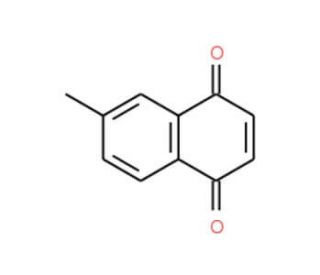

6-Methyl-1,4-naphthoquinone (CAS 605-93-6)
QUICK LINKS
6-Methyl-1,4-naphthoquinone is a compound that plays a significant role in the field of organic chemistry, particularly in studies related to electron transport and redox reactions. As a naphthoquinone derivative, it is often used as a model compound to understand the redox properties of quinones, which are important in various biological and chemical systems. In the area of materials science, 6-Methyl-1,4-naphthoquinone is investigated for its potential applications in the development of organic semiconductors and as a component in dye-sensitized solar cells. Its ability to undergo reversible redox reactions makes it an attractive candidate for use in energy storage devices, such as batteries and supercapacitors. Additionally, the compound is involved in research aimed at synthesizing novel organic molecules with potential applications in the design of new catalysts and the study of electron transfer processes.
6-Methyl-1,4-naphthoquinone (CAS 605-93-6) References
- Metalloporphyrin-Catalyzed Oxidation of 2-Methylnaphthalene to Vitamin K(3) and 6-Methyl-1,4-naphthoquinone by Potassium Monopersulfate in Aqueous Solution. | Song, R., et al. 1997. J Org Chem. 62: 673-678. PMID: 11671463
- Chemical profiles of scent gland secretions in the cyphophthalmid opilionid harvestmen, Siro duricorius and S. exilis. | Raspotnig, G., et al. 2005. J Chem Ecol. 31: 1353-68. PMID: 16222776
- Naphthoquinones and anthraquinones from scent glands of a dyspnoid Harvestman, Paranemastoma quadripunctatum. | Raspotnig, G., et al. 2010. J Chem Ecol. 36: 158-62. PMID: 20127150
- High conservatism in the composition of scent gland secretions in cyphophthalmid harvestmen: evidence from pettalidae. | Raspotnig, G., et al. 2012. J Chem Ecol. 38: 437-40. PMID: 22477025
- On the enigmatic scent glands of dyspnoan harvestmen (Arachnida, Opiliones): first evidence for the production of volatile secretions. | Raspotnig, G., et al. 2014. Chemoecology. 24: 43-55. PMID: 24634568
- Benzoquinones from scent glands of phalangiid harvestmen (Arachnida, Opiliones, Eupnoi): a lesson from Rilaena triangularis. | Raspotnig, G., et al. 2015. Chemoecology. 25: 63-72. PMID: 25774074
- A Model for Phylogenetic Chemosystematics: Evolutionary History of Quinones in the Scent Gland Secretions of Harvestmen. | Raspotnig, G., et al. 2017. Front Ecol Evol. 5: 139. PMID: 29527526
- Methyl-ketones in the scent glands of Opiliones: a chemical trait of cyphophthalmi retrieved in the dyspnoan Nemastoma triste. | Schaider, M., et al. 2018. Chemoecology. 28: 61-67. PMID: 29670318
- The scent gland chemistry of neogoveid cyphophthalmids (Opiliones): an unusual methyljuglone from Metasiro savannahensis. | Raspotnig, G., et al. 2019. Chemoecology. 29: 189-197. PMID: 31839693
- Accessing Chemo- and Regioselective Benzylic and Aromatic Oxidations by Protein Engineering of an Unspecific Peroxygenase. | Knorrscheidt, A., et al. 2021. ACS Catal. 11: 7327-7338. PMID: 34631225
- Comparison of the effects on mitochondrial function of a series of 2-methyl substituted 1,4-naphthoquinones to their 6-methyl counterparts. | Pisani, DE., et al. 1986. Biochem Pharmacol. 35: 2587-91. PMID: 3741461
- One- and two-electron reduction of 2-methyl-1,4-naphthoquinone bioreductive alkylating agents: kinetic studies, free-radical production, thiol oxidation and DNA-strand-break formation. | Giulivi, C. and Cadenas, E. 1994. Biochem J. 301 (Pt 1): 21-30. PMID: 8037673
Ordering Information
| Product Name | Catalog # | UNIT | Price | Qty | FAVORITES | |
6-Methyl-1,4-naphthoquinone, 1 g | sc-217359 | 1 g | $712.00 |
